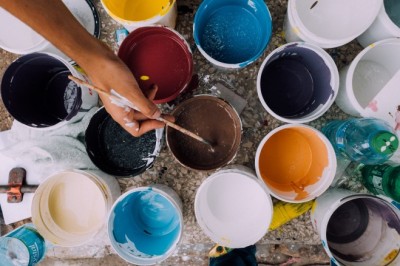Directoire and Empire Periods
Directoire (1795-1804)
After the Revolution, which was a barren period, artists and craftsmen took up their work again, but this time for the "new rich" instead of the Court and the nobility. They did not abandon the new classic styles, but emphasized their classic - Roman and Pompeiian - character; abandoned all that smacked of the old regime, and simplified detail and ornament producing a distinctive style - Le Style Directoire, named from the Directorate form of government which preceded Napoleons Consulate.
David, the former Court painter, became the real dictator of style and rose to even greater prominence under the Empire. He it was who gave his approval to Percier and Fontaine. He presented them to Napoleon, who commissioned them to remodel and refurnish Malmaison.
The characteristics of the Directoire period are less generally known than those of the other French decorative periods. Proportions were slender, projections were restrained - no heavy moldings or ornament encumbered the mode. Plastered walls were frequently featured though wood paneling continued: paneling was painted on plaster as in Pompeii.
Walls were paneled in Toile de Jouy, especially in monochrome cameo designs with classic motifs. Hand blocked papers like those designed by Lafitte, expensive scenic paper, small designs, or marbleized papers were used in panels with scenic papers. Dados of imitation papers were used. Windows and doors were square or round topped. Doors were simpler; classic pilasters often had plain entablatures and simple over-door ornamentation.
Ceilings were usually flat with a cornice. Furniture construction was classic, lighter than Empire which it resembled, rectilinear or with the typical curved backs or legs of ancient Rome. Ornament was classic, with less carving than in the Empire period; rosette wood corner blocks, metal mounts were of delicate classic design; upholstery of tapestry patterned with classic lamps, urns, and flowers. Guimpe and fringe were used with the upholstery, or seats were caned.
Empire (1804-1815)
When Napoleon, as a member of the Directorate succeeded by his military victories in establishing himself as Emperor, he deliberately undertook his own glorification, as did Louis XIV and other absolute rulers. His continuous military career left him little time for the amenities of life, but he established his imperial Court on the Roman ideal of military power and commissioned artists and craftsmen to provide him a setting to his own liking and one to impress upon the French populace the character of his reign. He made the Style Empire in so far as it differs from the Directoire from which it is an outcome.
David became the director of styles and proceeded to his work as frankly as a child. Military trophies were simply spotted and sprinkled over everything. Rooms were often treated to appear as the interior of gorgeous military tents. Walls were flat and fabric covered, or frescoed. Ordinary rooms were painted or papered. The Frieze became prominent. The dado disappeared. Doors were ordinarily single and plain, ornamented by a simple painted motif or paneled with a low molding. Floors were wood, plain or parquet; ceilings high and flat with applied flat ornament in the center or around the edge, and a restraining cornice.
The furniture was of mahogany, ebony and rosewood with strong rectangular and often heavy construction, or curved like Roman chairs; massive columns and architectural details. In simple chairs the broad top rail was typical. Excessive ornamental carving, brass and ormolu mounts, painting, gilding, molding and paneling; upholstery was in tapestry, velvet and damask, caning.
Classic ornament and Egyptian motifs celebrated Napoleons military victories. Much gilding characterized the Empire decoration together with strong coloring-Empire green, blue, yellow, and Imperial purple with red. On the whole the style is not particularly successful for modern adaptation, but it had a strong influence upon the art of America of the same period.
Sarah Martin is a freelance marketing writer based out of San Diego, CA. She specializes in interior design, and home improvement, such as rosette wood corner blocks. For the best in the hardwood moulding industry, please visit http://www.ferche.com/.























